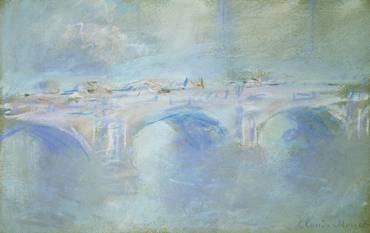The Unknown Monet
dal 16/3/2007 al 16/4/2007
Segnalato da
16/3/2007
The Unknown Monet
Royal Academy of Arts, London
Pastels and Drawings. Drawn from major institutions and private collections, the exhibition consists of 80 works, many of which have never been exhibited. Beginning with the artist's early caricatures and landscape studies, the show explores the genesis of his drawing skills and powers of observation during his career.

Pastels and Drawings
This exhibition is the first devoted to Monet’s drawings and pastels. It offers a ground-breaking exploration of the role of draughtsmanship throughout the artist’s long career, overturning the conventional notion that Monet painted his impressions of nature directly onto the canvas. New light is shed on Monet’s working methods by presenting a significant body of his preparatory studies, finished drawings and pastels, alongside representative examples of his paintings. In demonstrating the relationship between his works on paper and in oil, Monet’s hidden talent as a draftsman is revealed, a gift that he publicly disavowed.
Drawn from major public institutions and private collections, the exhibition consists of 80 works, many of which have never been exhibited. Beginning with the artist’s early caricatures and landscape studies, the exhibition explores the genesis of his drawing skills and powers of observation during his teenage years in Le Havre, while also showing his awareness of the prevailing graphic modes of the 1850s. The exhibition moves on to examine Monet’s use of drawing in the preparation of paintings such as the large, but aborted, Déjeuner sur l’herbe, and the Normandy landscapes of the 1860s. His mastery of pastel and the medium’s relationship to the oil paintings of the period is explored in telling juxtapositions. Links between drawing, pastel and painting are further established through Monet’s works in mid and late career. They include the scenes he executed at Etretat on the Normandy coast in the early 1880s; the series of Views of the Thames such as Charing Cross Bridge and Waterloo Bridge, begun on Monet’s trips to London between 1899 and 1901, remarkable for their fusion of pastel and paint; and the waterlily panels of the late 1910s, which stem from line drawings in sketchbooks inspired by his water gardens at Giverny.
A further section of the exhibition is devoted to the drawings Monet made of his paintings for reproduction in lithography in art journals such as L’Art dans les Deux Mondes. They highlight his engagement with printmaking techniques and the freedom with which he translated the painterly forms of his canvases into a personal language of line suitable for mass reproduction. Fundamental to our understanding of the artist’s œuvre is the dialogue between line and colour in Monet’s drawings and pastels. This important exhibition, the product of entirely new research, sheds new light on the role of drawing in Monet’s working practice, making direct connections to his paintings and exploring the often-overlooked links between the series paintings and his sketchbooks.
Opening: march 17, 2007
Royal Academy of Arts
Burlington House, Piccadilly - London



